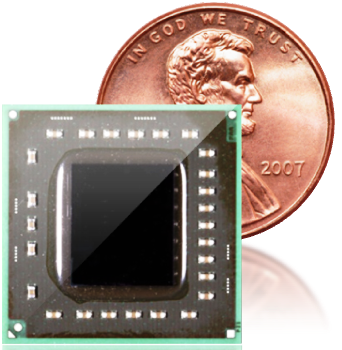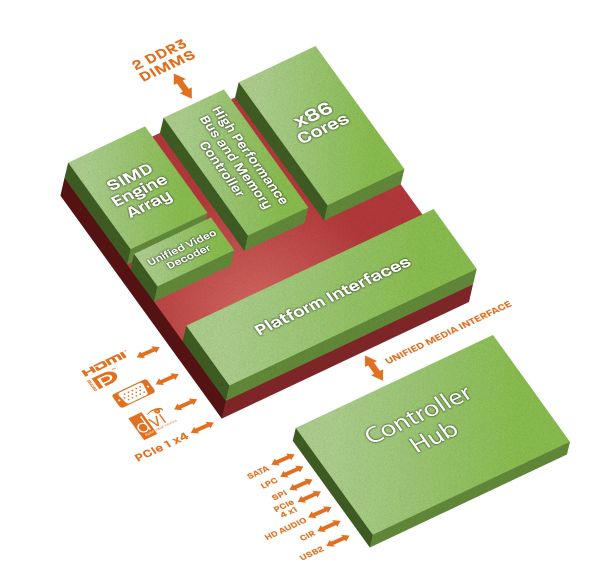AMD G-Series Brings APUs to the x86 Embedded Market
by Ganesh T S on January 19, 2011 12:29 AM ESTThe embedded market is huge and growing, and needs innovative, complete system platforms. These systems are compute intensive and have high performance graphics requirements, which make the embedded market a key part of AMD's strategy to drive revenue growth. There is an ongoing push for decreased power, smaller size and higher capability systems at lower price points. The strong visual element and growing need for quality graphics in many embedded markets such as set top boxes make it the ideal time for the AMD APU to get introduced into this space.

AMD's solutions (integrated CPU + GPU) are ideal for thin clients, medical imaging, point of sale and kiosk systems, gaming machines, digital signage and single board computing systems. These APUs integrate a multi-core CPU and a GPU sub-system on the same die to give a general-purpose, programmable scalar and vector processor core with heterogeneous capabilities.
The AMD Embedded G-Series Platform consists of an APU and a Fusion Controller Hub. The features are as below:
APU
- 2 x86 CPU Cores (40nm “Bobcat” core – 1 MB L2, 64-bit FPU)
- C6 and power gating
- Array of SIMD Engines [ DX11 graphics performance, Industry leading 3D and graphics processing ]
- 3rd Generation Unified Video Decoder [ H.264, VC1, DivX/Xvid ]
- DDR3 800-1066, 2 DIMMs, 64 bit channel
- BGA package
AMD Fusion Controller Hub for display and I/O
- Two dedicated digital display interfaces [ Configurable externally as HDMI, DVI, and/or Display Port, and as single link LVDS for internal panels ]
- Integrated VGA
- 5x8 PCIe®
- “Hudson” Fusion Controller Hub
With the introduction of the G-Series, AMD is showing a strong commitment to the x86 embedded market. AMD claims that it is the world's first and only APU for embedded systems. AMD Fusion can bring a new generation of differentiated, small form factor embedded systems that consume less power, yet deliver improved performance and features. The GPU component can deliver an outstanding visual experience compared to other x86 based embedded systems.
We are reproducing the different SKUs available for the APU as well as the platform controller hub (PCH) from AMD's official site below (click to enlarge):
Given ATI's strong GPU background, there is no doubt that the graphics in the G-Series will turn out to be much better than the embedded solution from Intel and VIA. However, we do have some concerns about the capability of the UVD engine in the platform. While the marketing slides indicated that Blu-Ray titles can be smoothly played back, it also had another entry indicating that 1080p video playback support availability was only in the 18W processors and higher. We were also not provided with the difference between the embedded G-Series and the desktop Brazos platform that Anand had covered earlier. It looks likely that the GPU capabilities (SIMD engine) are not the same, with the embedded solution having half the number of stream processors. However, we are awaiting confirmation on this. Expect an update in this section as soon as we hear back from AMD.













76 Comments
View All Comments
ninjaquick - Wednesday, January 19, 2011 - link
Yeah, I'm personally curious to see what nvidia cooks up with ION+ARM.mino - Wednesday, January 19, 2011 - link
Yeah. But it has "no information" mostly because of all the leaks over the past 2 quarter mean that we "knew" it long before.But agreed, this should have been a one-pager focused on confirming the OLD rumors and adding a _little_ bit of commentary to it. 1/2 the text is either spin or bloat.
This article will be top-of-the-line on NYT, but this site has a much more demanding and knowledgeable audience ...
wolfman3k5 - Wednesday, January 19, 2011 - link
Hey Anand, sucking on the wrong tit? I thought that Intel was the correct tit... Anyway, I guess that the way this thing is written just shows the laziness on your part guys. Too bad...ganeshts - Wednesday, January 19, 2011 - link
This is a 'News' piece, which means we try to convey what is in the press release, followed by presenting our analysis of the same. Please take a look at my reply to brunnis above.In any case, please let me know if you want 'News' pieces to be presented in any other way.
MeanBruce - Wednesday, January 19, 2011 - link
Hey now, let's don't bring yammos into this. We should leave beautiful size F yammos right where they belong, on long narrow torsos. I hope May isn't reading this, hi honey!AssBall - Wednesday, January 19, 2011 - link
I thought Wolfman only injected his trolling nonsense on Intel articles.wolfman3k5 - Wednesday, January 19, 2011 - link
Good Job! Looks like you're catching on. And by the way, I love yammos! Big ones on long narrow torsos!Jesus, some of you take everything to seriously! Just like a bunch of geeks and neerds! Get a life for God's sake!
milkylainen - Wednesday, January 19, 2011 - link
I for one, am sick of hearing the word "Embedded". Seems like no one really has a clue to what embedded should mean.This new "class" of CPU's are nothing more than downscaled desktop counterparts.
Integrated video? Big whoop, come again when you have integrated _everything_ into one SoC, including the southbridge.
And don't come claiming embedded with a TDP of 18w. That's just grotesque.
Anything above 1w of TDP is not embedded, and will probably require some sort of passive cooling at the least to survive industrial if not military embedded solutions.
Calling them "netbook"-class or something alike is more useful. Embedded is just plain wrong.
ganeshts - Wednesday, January 19, 2011 - link
Agree with you partially (refer to my conclusions, comparing with the CE4100) :)But, Intel, VIA and AMD seem to have a different interpretation of 'Embedded' ..
Anyways, there are embedded applications like digital signage and point of sale systems which are almost PC-like in nature.. I think the x86 solutions are targeting that currently.. Also, embedded solutions have much longer support cycles compared to the traditional PC platform (The Geode is not going EOL until 2015, for example)... It is a matter of the company willing to support a product for an extended period of time too.
pk05 - Wednesday, January 19, 2011 - link
agreed, people basically use embedded to mean "not a pc", which is meaningless given the huge range of aplications in embedded. that being said, this processor does seem to be targeting certain areas of that huge embedded space that don't have the 1w tdp requirement. industrial and military are clearly not the focus here.